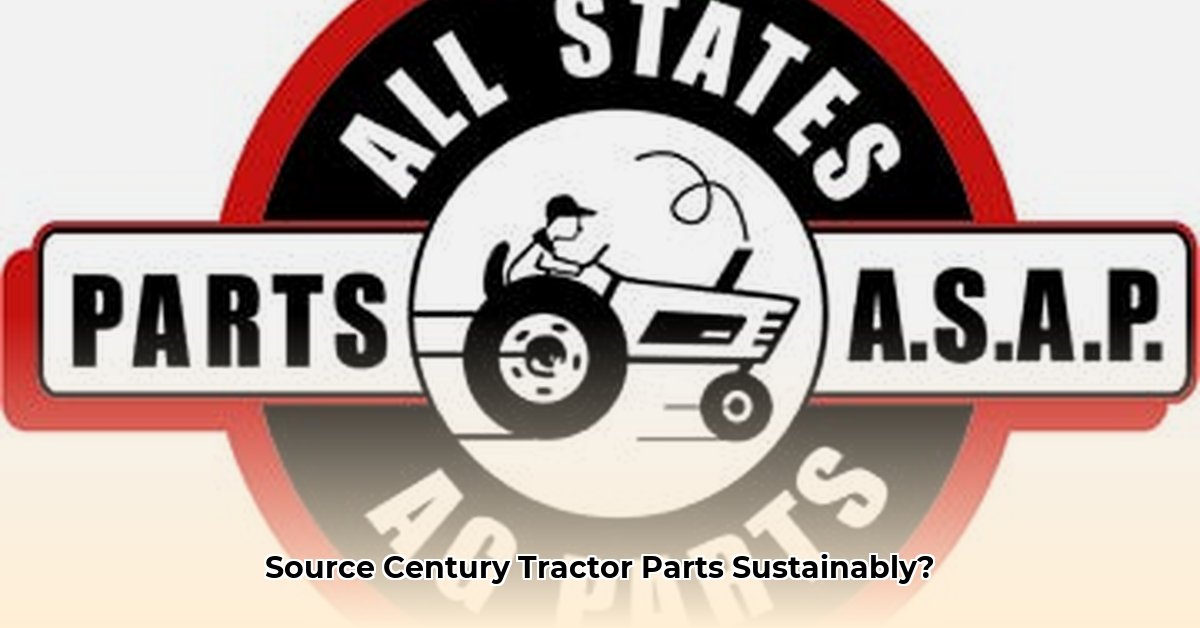
Finding the right parts for your Century tractor can be a challenge, but it doesn't have to be a headache. This guide provides actionable steps to source parts sustainably, keeping your tractor running efficiently while minimizing environmental impact. We'll cover everything from inventorying your current parts to exploring environmentally conscious choices and developing a long-term maintenance plan. For additional parts resources, check out Bradish Tractor Parts.
Assessing Your Needs: Inventory and Prioritization
Before searching for parts, conduct a thorough inventory of your Century tractor's components. This detailed assessment is crucial for targeted searches, avoiding wasted time and resources. Carefully inspect each part for wear, damage, or signs of impending failure. Note the condition of each part, its part number (if visible), and estimate its remaining lifespan. This helps you prioritize which parts need replacing urgently. Crucially, locate your tractor's model number (usually on a plate on the tractor) – this is essential for accurate part ordering. Don't forget to consider the frequency of use for each part; high-use components might warrant keeping spares on hand.
Sourcing Parts: A Multi-Faceted Approach
Finding Century tractor parts often requires a multi-pronged strategy. Here’s how to maximize your chances of success:
Online Marketplaces: Numerous online retailers specialize in hard-to-find agricultural parts. Search using your tractor's model number and specific part numbers. Compare prices and seller reviews meticulously. Beware of counterfeit parts; always verify the seller’s reputation and check for customer testimonials or certifications.
Local Dealers and Specialists: Contact agricultural equipment dealers in your area. They may have parts in stock or know where to source them. Local small engine repair shops also could be a good resource. Their expertise in older machinery is invaluable.
Online Forums and Communities: Engage with online communities dedicated to Century tractors. These groups connect owners and specialists who share advice and potential part sources. This is especially helpful for less common parts.
Manufacturer's Resources (if available): While unlikely for older models, check if Century still offers parts or has an archive or designated supplier.
Verifying Part Quality and Compatibility
Always verify that any potential part is genuine and compatible before purchase. Look for quality certifications. Don’t hesitate to contact the seller with questions about the part's origin, materials, and manufacturing processes. Investing in a high-quality, authentic part is crucial for longevity, even if it’s more expensive. A poorly-made part could lead to further damage or even safety hazards.
Sustainable Practices: Environmentally Responsible Choices
Sustainable farming involves minimizing environmental impact. Here's how to apply this to Century tractor parts management:
Recycling Old Parts: Research local recycling centers or scrap metal yards specializing in agricultural equipment. Many components can be recycled or repurposed.
Sustainable Alternatives: Explore sustainably manufactured parts. While options may be limited, the agricultural machinery industry increasingly uses recycled materials and more eco-friendly manufacturing processes.
Proper Disposal: Dispose of unusable parts responsibly, avoiding dumping or improper disposal. This protects the environment and complies with local regulations. Improper disposal can harm local ecosystems and soil health.
Preventive Maintenance: Proactive Protection
Regular maintenance is the best way to reduce part replacements. A proactive approach significantly extends the lifespan of your tractor and minimizes unexpected breakdowns. Regular servicing, including lubrication, inspections, and adjustments, helps discover and address potential issues before they become major problems. Is it worth risking a costly repair down the road by skipping routine maintenance?
Long-Term Planning: A Comprehensive Strategy
Develop a comprehensive parts inventory and maintenance schedule. This proactive approach anticipates needs, ensuring parts availability and preventing unexpected downtime. Keep a detailed log of repairs and replacements for future reference; this valuable information helps anticipate future needs and improves long-term planning. Consider the cost of replacement parts when evaluating different maintenance schedules – consistent maintenance is often cheaper in the long run than emergency repairs.
Resources
While specific URLs for parts suppliers aren't available here, searching online using terms like "Century tractor parts," "vintage tractor parts," or "agricultural machinery parts suppliers" (along with your geographical location) will yield helpful results. Consider contacting your local agricultural extension office for guidance on sustainable practices and reputable parts suppliers.
Key Takeaways:
- Proactive parts management is crucial for efficient and sustainable Century tractor operation.
- Strategic sourcing and environmentally conscious choices minimize environmental impact.
- Preventive maintenance significantly reduces the need for frequent part replacements, saving you both time and money.
- Long-term planning, including creating a parts inventory and a detailed maintenance schedule, maximizes your tractor's lifespan and operational efficiency.